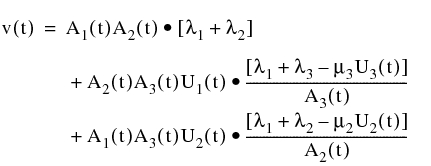Failure Frequency Calculations
The failure frequency of the system can be calculated. In some engineering books and sources, failure frequency is referred to as failure rate. Failure frequency is the number of failures per unit time at a specified point in time. The RBD module supports both steady state and time-specific failure frequency calculations. Time-specific frequency (frequency) corresponds to a specific point in time, whereas steady state frequency corresponds to the time as it tends to infinity.
The calculations in the analytical method for finding the failure frequency are more complex than availability calculations. The analytical method makes use of the availability function to compute failure frequency. This means that both availability and failure frequency are calculated simultaneously to compute system failure frequency. Depending upon the type of analytical method used to calculate availability, different formulas for calculating failure frequency are used.
If the availability of a system, A(t), is expressed in the sum of the product form of component availabilities containing the terms as:

Then, the failure frequency is calculated using the following equation:



Where:
v(t) = The failure frequency of the system.
λ t = The failure rate of component i.
A i(t) = The availability of the component i.
t 1 and t 2 = The starting and ending points of the time interval.
If the product terms contain mixed terms of availability and unavailability, then the rate term corresponding to the unavailability of component i should be:

Whereas the rate term corresponding to availability of component i is λ i. Here, μ i is the repair rate of component i, and U i(t) is the unavailability of component i.
Simple Parallel System Example
Consider a parallel system with three components, where two components are required for successful operation of the system. Availability of this system can be expressed as:

Then, the failure frequency of the system is:

Moreover, availability of the same system can be expressed as follows:

Then, the failure frequency of the system is:

Similar formulas and some simplifications for other forms of availability expressions are used. For example, in using the factorization method for computing availability of a system, the availability can be expressed as:

Where:
 = The conditional availabilities of the system given that component i is working.
= The conditional availabilities of the system given that component i is working. = The conditional availabilities of the system given that component i is not working.
= The conditional availabilities of the system given that component i is not working.In this case, failure frequency is calculated as follows:

Where:
 = The conditional failure frequencies of the system given that component i is working and that it is calculated recursively along with availability calculations.
= The conditional failure frequencies of the system given that component i is working and that it is calculated recursively along with availability calculations. = The conditional failure frequencies of the system given that component i is not working and that it is calculated recursively along with availability calculations.
= The conditional failure frequencies of the system given that component i is not working and that it is calculated recursively along with availability calculations.Furthermore, v i(t) is the failure frequency of component i:

The failure frequency calculations with the simulation method are easy and straightforward. The basic simulation procedure is the same as that used for availability calculations. At each time point of interest, the number of failures in a unit time is counted at each run. The average of these values over the total number of simulations gives the failure frequency at that time point.